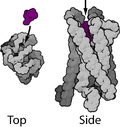Endomorphin
Endomorphin refers to two opioid peptides, named endomorphin-1 and endomorphin-2. These peptides are known for their high affinity and specificity for the μ-opioid receptor. Endomorphins are considered to be natural endogenous ligands for the μ-opioid receptor, which is a critical receptor in the modulation of pain and analgesia in the human body. The discovery of endomorphins has contributed significantly to the understanding of pain management and the development of pain-relieving drugs.
Discovery
Endomorphins were discovered in the late 1990s through the efforts of researchers looking for natural ligands of the μ-opioid receptor. Their discovery was significant because it provided insight into the body's natural mechanisms for modulating pain and offered potential pathways for developing new analgesic drugs.
Structure
Endomorphin-1 and endomorphin-2 are tetrapeptides, meaning they are composed of four amino acids. The sequence for endomorphin-1 is Tyr-Pro-Trp-Phe, and for endomorphin-2, it is Tyr-Pro-Phe-Phe. This small size and specific amino acid sequence contribute to their high affinity and specificity for the μ-opioid receptor.
Function
The primary function of endomorphins is to bind to the μ-opioid receptor, leading to analgesia or pain relief. They are part of the body's endogenous opioid system, which is involved in a variety of physiological processes, including pain modulation, stress response, and immune response. Endomorphins play a crucial role in this system by modulating pain and reducing the perception of pain in the central nervous system.
Clinical Significance
The high specificity of endomorphins for the μ-opioid receptor makes them of particular interest for the development of new analgesic drugs. Unlike synthetic opioids, which can have a wide range of side effects and a high potential for addiction and abuse, endomorphins offer the possibility of developing pain relief medications with fewer side effects and lower risks of addiction.
Research and Development
Research into endomorphins is ongoing, with studies focusing on understanding their role in pain modulation, their potential therapeutic applications, and the development of synthetic analogs that can mimic their action. The goal is to develop drugs that can provide effective pain relief without the drawbacks associated with current opioid medications.
Conclusion
Endomorphins represent a significant area of interest in the field of pain management and drug development. Their discovery has opened new avenues for understanding how the body modulates pain and for developing new, more effective, and safer analgesic drugs.
Transform your life with W8MD's budget GLP-1 injections from $125.
W8MD offers a medical weight loss program to lose weight in Philadelphia. Our physician-supervised medical weight loss provides:
- Most insurances accepted or discounted self-pay rates. We will obtain insurance prior authorizations if needed.
- Generic GLP1 weight loss injections from $125 for the starting dose.
- Also offer prescription weight loss medications including Phentermine, Qsymia, Diethylpropion, Contrave etc.
NYC weight loss doctor appointments
Start your NYC weight loss journey today at our NYC medical weight loss and Philadelphia medical weight loss clinics.
- Call 718-946-5500 to lose weight in NYC or for medical weight loss in Philadelphia 215-676-2334.
- Tags:NYC medical weight loss, Philadelphia lose weight Zepbound NYC, Budget GLP1 weight loss injections, Wegovy Philadelphia, Wegovy NYC, Philadelphia medical weight loss, Brookly weight loss and Wegovy NYC
|
WikiMD's Wellness Encyclopedia |
| Let Food Be Thy Medicine Medicine Thy Food - Hippocrates |
Medical Disclaimer: WikiMD is not a substitute for professional medical advice. The information on WikiMD is provided as an information resource only, may be incorrect, outdated or misleading, and is not to be used or relied on for any diagnostic or treatment purposes. Please consult your health care provider before making any healthcare decisions or for guidance about a specific medical condition. WikiMD expressly disclaims responsibility, and shall have no liability, for any damages, loss, injury, or liability whatsoever suffered as a result of your reliance on the information contained in this site. By visiting this site you agree to the foregoing terms and conditions, which may from time to time be changed or supplemented by WikiMD. If you do not agree to the foregoing terms and conditions, you should not enter or use this site. See full disclaimer.
Credits:Most images are courtesy of Wikimedia commons, and templates, categories Wikipedia, licensed under CC BY SA or similar.
Contributors: Prab R. Tumpati, MD



